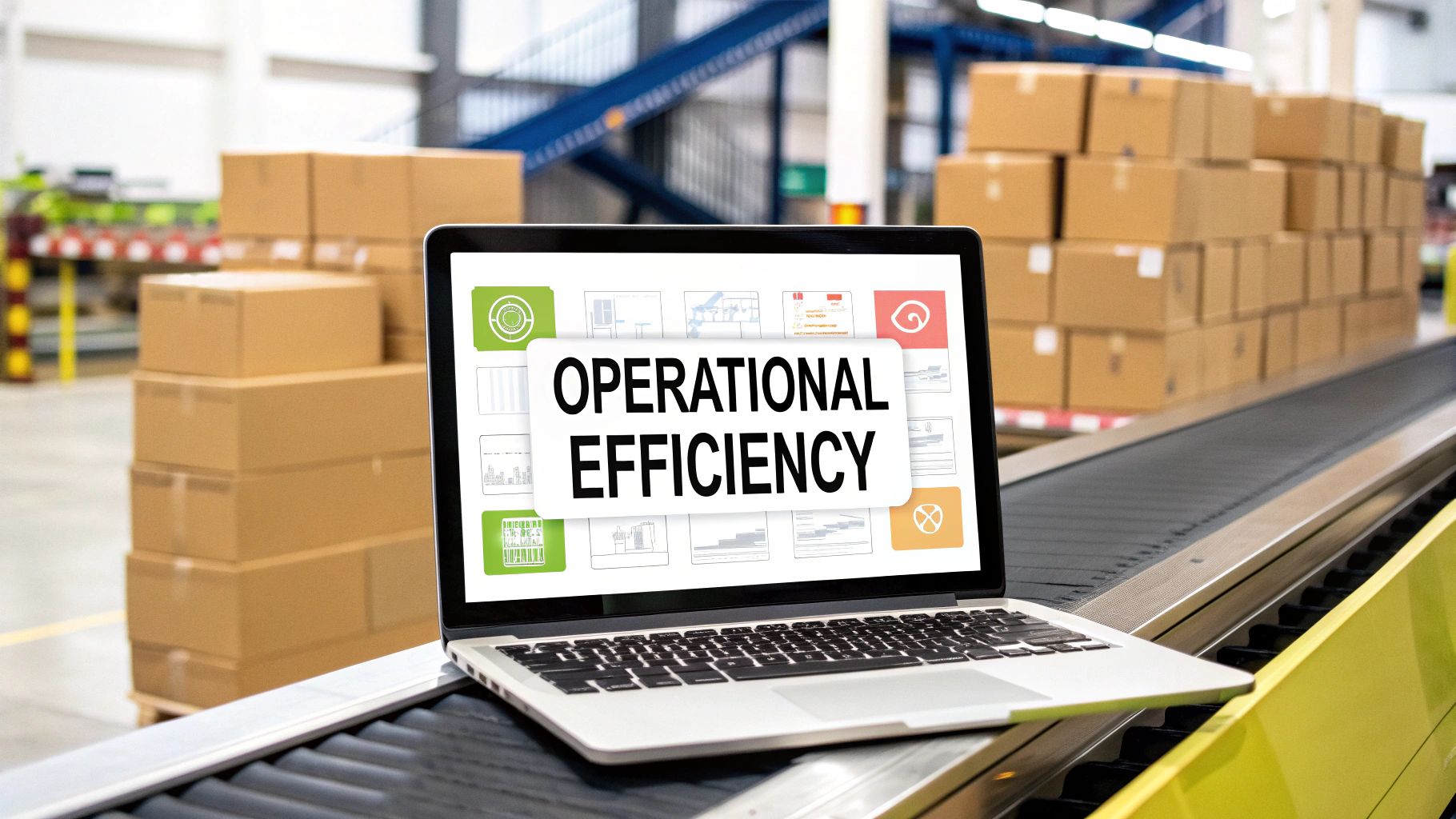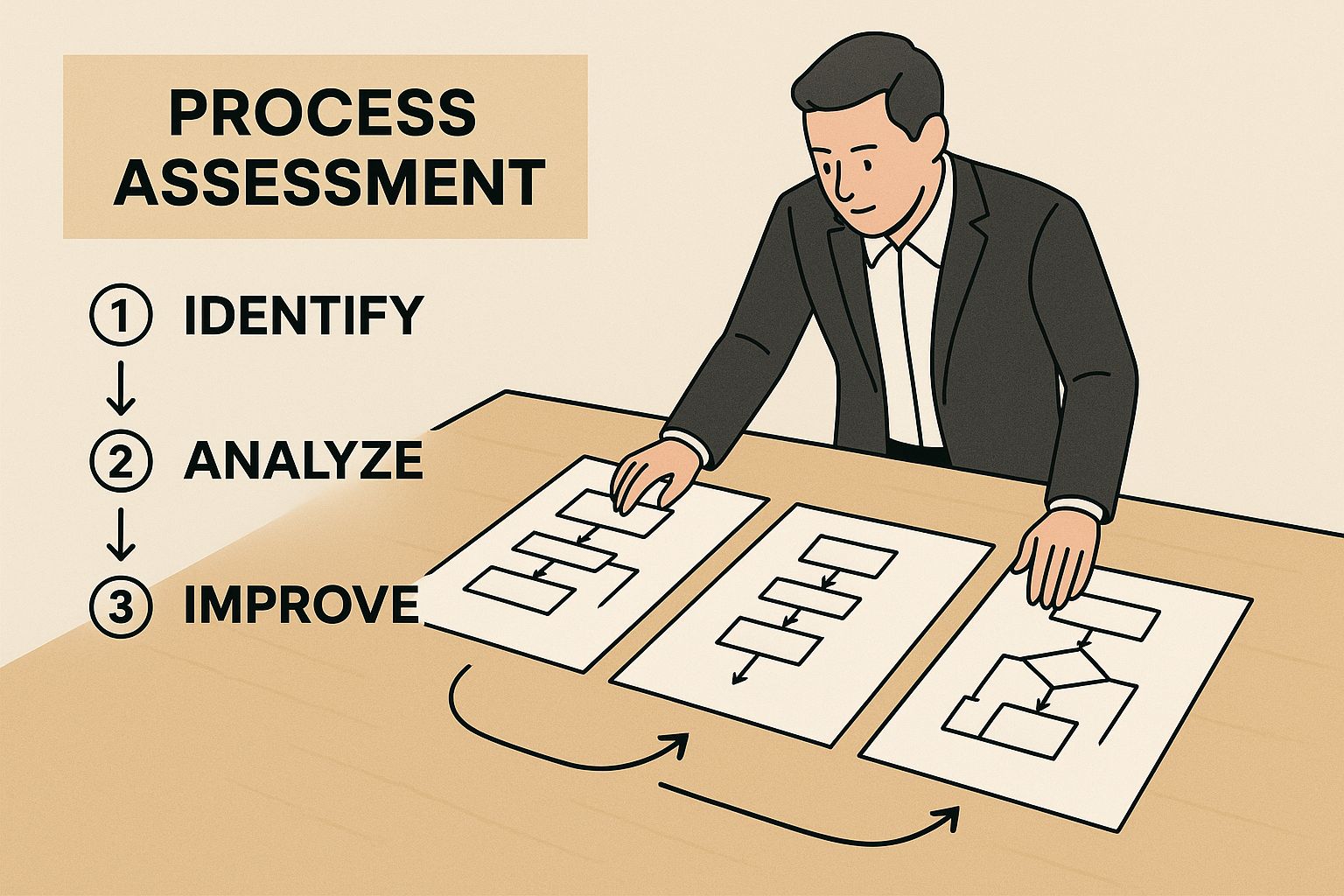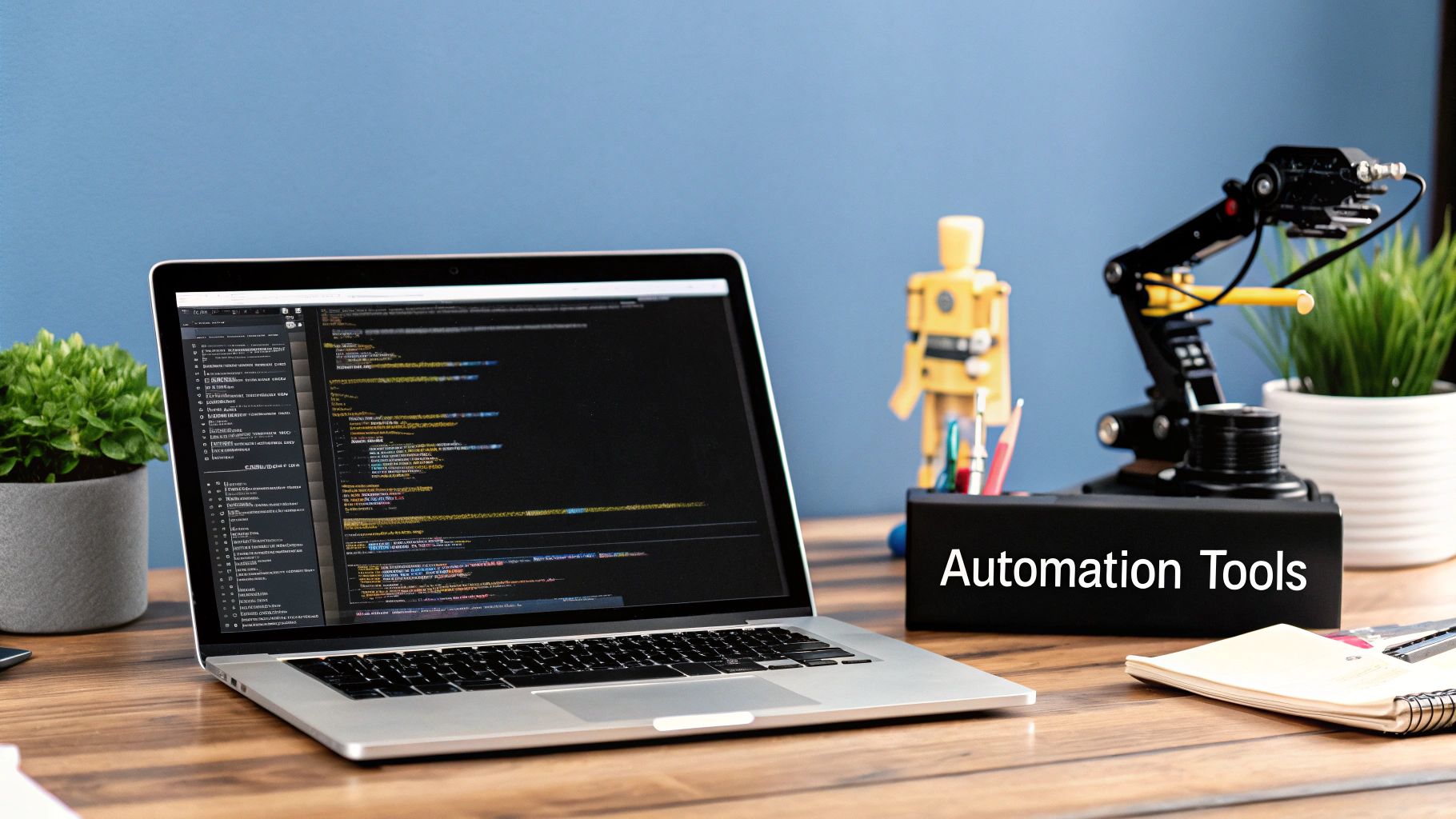Stay Updated with Everything about MDS
Thank you! Your submission has been received!
Oops! Something went wrong while submitting the form.

Chilat Doina
August 12, 2025
Improving operational efficiency isn't just a corporate buzzword; for an e-commerce founder, it’s about building a smarter, more resilient business that can actually scale without descending into chaos. It's the difference between constantly putting out fires and proactively building for the future.
This means putting a clear framework in place that focuses on three core areas: transparent processes, smart technology adoption, and a genuinely empowered team culture. When you get these right, you systematically cut costs, slash errors, and—most importantly—reclaim your own time to focus on growth.
Let's be clear: true operational efficiency is way more than just cutting a few costs here and there. It's the engine that powers sustainable growth and keeps your customers happy. As a founder, it means creating systems that work for you, not the other way around.
Forget about massive, disruptive overhauls. Real, lasting improvement comes from making targeted, intelligent changes that compound over time.
Think of it like building a high-performance race car. You wouldn't just obsess over the engine. You’d also fine-tune the aerodynamics, perfect the suspension, and train the driver. Your business needs that same holistic approach, carefully balancing your processes, technology, and people.
To build an operation that truly hums, you need a framework resting on three essential pillars. Each one supports the others, creating a powerful synergy that pushes your business forward.
This framework isn't a one-and-done fix; it’s a continuous cycle of improvement. As you build out your strategy, you’ll find that specific tactics, like boosting operational efficiency through labelling, can have an outsized impact on your workflows. Strong vendor relationships are another critical piece of the puzzle—check out our guide on vendor management best practices for deep-dive tips on that.
A classic mistake I see founders make is treating efficiency as a purely top-down directive. The most successful e-commerce brands are the ones that build a culture where every single team member feels a sense of ownership over their daily processes.
Ultimately, the best returns will always come from investing in your people and your processes. The data backs this up. Global research shows 51% of executives see employee upskilling as their top priority for boosting productivity. This is followed closely by well-being initiatives (45%) and workflow optimization (44%). The path to a leaner, more profitable business runs directly through your team and your systems.
To help you get started, here's a quick look at some core strategies, their impact, and what kind of investment they typically require. Think of this as a menu of options you can start exploring for your own business.
These strategies aren't just checkboxes; they are foundational elements that build upon each other. Start small, pick one or two areas where you know there's friction, and build momentum from there. The goal is progress, not overnight perfection.
You can't fix a problem you can't see. Before you start throwing money at fancy software or shaking up your team, the single most powerful thing you can do for your operational efficiency is to get a brutally honest picture of how work actually gets done.
This is where workflow mapping comes in.
It sounds way more complicated than it is. Forget expensive consultants and complex diagrams for now. You can literally start with a whiteboard, a stack of sticky notes, or a free tool like Miro. The goal is simple: visually chart out every single step of your most critical—and likely most frustrating—processes.
This is how you turn that vague feeling of "things are slow" into a concrete, actionable plan. A detailed process map is like an X-ray of your business, revealing the hidden fractures, redundant tasks, and communication gaps that are quietly bleeding your resources and profits.
Here, a professional consultant digs into the details by examining flowcharts—a critical step in understanding where the real-world inefficiencies are hiding.

This kind of hands-on, granular examination of printed process flows is essential. It’s about seeing the true dynamics of your workflow, not just the idealized version in your head.
For almost every e-commerce brand, the highest-impact place to start is order fulfillment. Think about it: this process touches nearly every part of your operation, from inventory and warehousing to customer service and returns. It’s also the place where small slip-ups can snowball into costly mistakes and angry customers. Fast.
Let's walk through a real-world scenario. Imagine mapping the journey of a single order, from the moment a customer clicks "buy" to the second it's scanned by the carrier.
Your map kicks off with the trigger: "Customer Places Order." From there, you just keep asking, "What happens next?"
By laying it all out, you shift from the high-level concept of "we ship orders" to a ground-level, step-by-step reality. And it’s in those gritty details that the gold—the opportunities for improvement—is hiding.
With your map laid out, it's time to play detective. Grab your team and walk through each step, asking the tough questions. This is where you’ll pinpoint the friction points that are costing you real time and money.
Look for these common culprits:
A classic mistake is assuming your process works the way you designed it. The truth is, your team has likely created informal workarounds to deal with system flaws. Mapping reveals what actually happens, not what you think happens.
Once you’ve spotted potential bottlenecks, you need to measure their impact. Attaching hard numbers to these issues is what turns vague problems ("packing feels slow") into solvable equations ("packing one order takes 3 minutes too long"). This gives you a baseline, so you can actually track if your changes are working.
Here are a few essential metrics to start tracking for your fulfillment workflow:
By mapping your workflows and then tracking these key metrics, you’re no longer just guessing. You’re building a data-backed roadmap to create a leaner, faster, and more profitable operation.
Once you’ve mapped your workflows and stared all those inefficiencies right in the face, the next move is bringing in technology to do the heavy lifting. Automation isn't about replacing your team. It's about freeing them from the repetitive, soul-crushing tasks that suck the life, time, and energy out of their day. For any growing e-commerce brand, this is how you scale without your overhead costs exploding.
The trick is to start smart. You don't need a massive budget or a dedicated dev team to see a real impact. The goal is to find those prime candidates for automation—the manual, recurring tasks you hopefully circled in red during your process mapping. I'm talking about things like manual data entry, sending out shipping confirmations one by one, or frantically updating inventory levels across your website, Amazon, and Etsy stores.

This is the core of smart automation: getting your separate systems to talk to each other. It creates a smooth, efficient flow of information, which is non-negotiable for modern e-commerce operations.
The best places to start are the tasks that are highly repetitive, follow simple rules, and are magnets for human error. These are your quick wins. They deliver immediate value and build the momentum you need to tackle bigger projects down the road.
Here are some classic e-commerce headaches just begging to be automated:
The single most impactful strategy for boosting operational efficiency is leaning into automation, especially now with all the accessible low-code and no-code tools available. Companies that adopt these platforms can shift their teams away from routine tasks and onto strategic work that actually grows the business. But remember, you have to map your processes first. Simply automating a broken workflow just helps you do the wrong thing faster. You can find more insights on automation trends that streamline operations on sdocs.com.
The best part? You no longer need to be a developer to build powerful automations. The market is full of user-friendly platforms designed for founders like us. These tools are the "glue" that connects the different apps you already use every day.
Automation tools are everywhere, but finding the right one depends on what you're trying to fix. The table below breaks down some common pain points and the types of tools that can solve them.
Choosing the right tool from this list can immediately claw back hours of your team's time, freeing them up for work that truly matters.
For connecting everything else, these platforms are indispensable:
The real magic happens when you get your core systems integrated. Connecting your e-commerce platform (like Shopify or BigCommerce) to your shipping software (like ShipStation) and your email marketing platform creates that seamless, automated data flow we're all chasing.
This isn't just a convenience. It eliminates countless hours of manual work, slashes the risk of costly errors, and ensures your customer data is always accurate across your entire tech stack. That’s a fundamental building block for a scalable, efficient, and profitable e-commerce business.
Mapping your workflows and plugging in new tech are massive steps forward. But let's be real—the most advanced systems on the planet mean nothing if the people using them aren't bought in. Your team isn't just a line item on a budget; they are your single most powerful operational asset.
Building a culture of continuous improvement means getting out of that top-down, reactive mindset. It's about creating an environment where everyone, from the person packing boxes to the customer service lead, feels a sense of ownership. This isn't just about warm-and-fuzzy morale. It’s about creating a flywheel of ongoing optimization that scales right alongside your brand.
When your team is truly engaged, they stop seeing problems as "somebody else's issue." They start seeing them as opportunities. They become the eyes and ears of your entire operation, spotting tiny cracks before they turn into catastrophic failures.
You can't expect your team to nail a process they don’t fully understand. This is where clear, accessible Standard Operating Procedures (SOPs) are worth their weight in gold. An SOP isn't some dusty binder on a shelf—it's a living document, the single source of truth for getting a task done right.
When you create detailed SOPs, you aren’t micromanaging. You’re giving your team the power of clarity and consistency.
Think about an SOP for handling customer returns. It should walk through every single step, from generating the return label to inspecting the item and processing the refund. This removes all the guesswork, speeds up the entire workflow, and creates a much smoother experience for your customer.
Documenting your processes is only half the battle. The real magic happens when you build a system that encourages your team to challenge and improve those very processes. They’re on the front lines, and they know what’s broken way before you do.
You need to establish a formal feedback loop. This doesn't have to be some complicated, bureaucratic system. It can be as simple as a dedicated Slack channel or a quick 15-minute huddle where the only agenda item is, "What slowed us down this week?" The point is to make it safe and easy for people to speak up.
When an employee suggests an improvement, act on it. Even if the idea isn't perfect, testing it proves you value their input. That validation is the fuel for a culture of continuous improvement and makes people eager to share their next great idea.
For example, a customer service rep might notice they spend 20 minutes a day answering the exact same question about shipping times. Empowered to suggest a fix, they might propose adding a dynamic shipping estimator to the product page. Implementing that small change saves them time and improves the experience for every future customer.
This kind of proactive problem-solving is a hallmark of truly elite teams. If you’re looking to cultivate this in your own company, our guide on building high-performing teams is a fantastic resource to dig into.
Putting money into your team's skills and tools is a direct investment in your operational efficiency. This is especially true as technology, like AI, becomes more common. The goal isn't to replace people; it's to augment them.
The data backs this up. Companies that smartly use AI technology report a 72% increase in productivity and a 59% boost in job satisfaction. Why? Because the tech handles the mind-numbing, repetitive tasks, freeing up your team for more strategic and fulfilling work. In fact, 75% of knowledge workers say AI helps them save time, improve their focus, and even boosts their creativity. Dive into more of these trends with these insightful employee productivity statistics.
Ultimately, building this culture means treating your team like partners in efficiency. Give them clear processes, listen to what they have to say, and arm them with the tools to win. When you do that, you unlock a level of operational excellence that no piece of software can ever achieve on its own.

Here's a tough lesson many founders learn too late: operational excellence isn’t a one-and-done project. It’s a habit. The process maps and automations you’ve built are a fantastic starting point, but they're not set in stone.
Think of it this way: you’ve just built a high-performance engine for your business. Now you need a dashboard with the right gauges to make sure it keeps running smoothly. This is where data becomes your most reliable co-pilot, helping you spot trouble before it gets out of hand.
This creates a powerful feedback loop—a rhythm of measuring, analyzing, and improving. It’s what keeps your operations lean and mean as you scale.
Let's get real. Vanity metrics like website traffic are nice for your ego, but they don't tell you a thing about your operational health. To get a true pulse on your business, you need to focus on the Key Performance Indicators (KPIs) that reflect what's happening on your warehouse floor.
Knowing how to measure productivity at work effectively is a great start, but for e-commerce, these specific metrics are non-negotiable.
Tracking these numbers gives you an honest, real-time look at how your operations are really performing.
You don't need a fancy, expensive BI platform to get started. Honestly, a well-organized Google Sheet can work wonders. The whole point is to get your most important numbers in one spot so you can see trends without digging through spreadsheets for an hour.
Keep it visual. Use clean, simple charts to track each KPI over time. A line chart showing your Cost Per Order for the last six months will instantly tell you if you’re heading in the right or wrong direction.
Pro Tip: Don't just track the data—set goals. Aim to keep your On-Time Shipment Percentage at 99.5% or slash your Cost Per Order by 10% next quarter. This turns your dashboard from a simple report into a real performance management tool.
Your dashboard is worthless if you don't act on what it tells you. This is the fun part—connecting the numbers to what's actually happening on the ground. It's also where you see how small operational tweaks can have a big impact on your bottom line and pricing power. To see how these costs fit into the bigger picture, check out our guide on e-commerce pricing strategies.
Here’s how to start connecting the dots:
This rhythm of measure, interpret, act is what separates the good operators from the great ones. Set up a monthly or quarterly review with your team to go over the dashboard. Celebrate the wins, figure out what went wrong, and pick one or two key things to fix in the next cycle. This is how you build a culture of constant improvement—the real engine of your growth.
As you start digging into your business operations, you’re going to have questions.You’re not alone. Optimizing your e-commerce engine is a journey, and hitting a few walls or feeling unsure about the next move is just part of the process.
Let's walk through some of the most common questions we see founders wrestle with when they first get serious about efficiency. Think of these as quick, straight-to-the-point answers to get you unstuck and moving forward with confidence.
Hands down, the first thing you need to do is map your core business processes. Before you even think about new software or hiring someone, you absolutely have to get a clear, visual picture of how work actually gets done right now.
And don't make this more complicated than it needs to be. Grab a whiteboard or a free tool like Miro and start with your most critical—and often most painful—workflow, like order fulfillment. Trace every single step, from the moment a customer clicks "buy" to the second that package leaves your facility.
A simple flowchart that you actually finish is infinitely more valuable than some perfect, complex diagram you give up on. This first map is your "you are here" pin on the roadmap. It will immediately shine a spotlight on the bottlenecks, redundant tasks, and communication gaps that are quietly bleeding time and money every day.
Yes. 100%. The idea that automation is just for giant corporations with bottomless budgets is a total myth. Thanks to an explosion of incredibly powerful and user-friendly low-code and no-code tools, automation has never been more accessible.
You don't need a team of developers or a massive upfront investment to see a huge return.
That reclaimed time is your new superpower. It can be poured back into things that actually grow the business—marketing, talking to customers, or developing that next winning product.
This is critical. Team buy-in is non-negotiable. You could design the most brilliant, efficient workflow on the planet, but if your team doesn't adopt it, it's worthless. The secret? Stop telling and start involving.
Don't just walk in on a Monday morning and announce, "Here's the new way we're doing things." That top-down approach is a recipe for resentment and failure. Instead, bring them the problem you discovered during your process mapping.
Frame it as a shared challenge. Say something like, "Hey team, I've noticed our returns process is causing a lot of friction and leading to some unhappy customers. I'd love to get your take on where the biggest headaches are for you."
Your team is in the trenches every single day. They know where the real bodies are buried and often have incredible ideas for how to fix things. Asking for their input shows you respect their experience.
Key steps for getting everyone on board:
When your team feels like they are architects of the change, not victims of it, they become your biggest champions for efficiency.
For a growing e-commerce brand, a quarterly review of your key operational processes is a solid rhythm. This doesn't have to be some stuffy, all-day affair. A focused 90-minute session to look at your main KPIs—like shipping error rates, cost per order, or fulfillment speed—is perfect.
The point of this check-in is to see what’s working, what's broken, and to pick one or two priorities to improve over the next 90 days. It creates a predictable cycle of improvement that keeps you from getting complacent.
But the real magic happens when you build a culture where improving processes is an everyday thing, not just a quarterly meeting. Empower your team to call out inefficiencies the moment they see them. Your biggest advantage as a growing brand is your ability to move fast. Don't wait three months to fix a problem you can solve today.
At Million Dollar Sellers, we know these are the exact challenges and questions that serious e-commerce entrepreneurs grapple with every day. Our exclusive community is built on sharing real-world solutions to these very problems, connecting you with a network of peers who have already navigated the path to 8- and 9-figure scale. If you're ready to stop guessing and start implementing proven strategies from the best in the business, find out if you qualify to join us.
Learn more about joining the premier community for top e-commerce entrepreneurs at https://milliondollarsellers.com.
Join the Ecom Entrepreneur Community for Vetted 7-9 Figure Ecommerce Founders
Learn MoreYou may also like:
Learn more about our special events!
Check Events